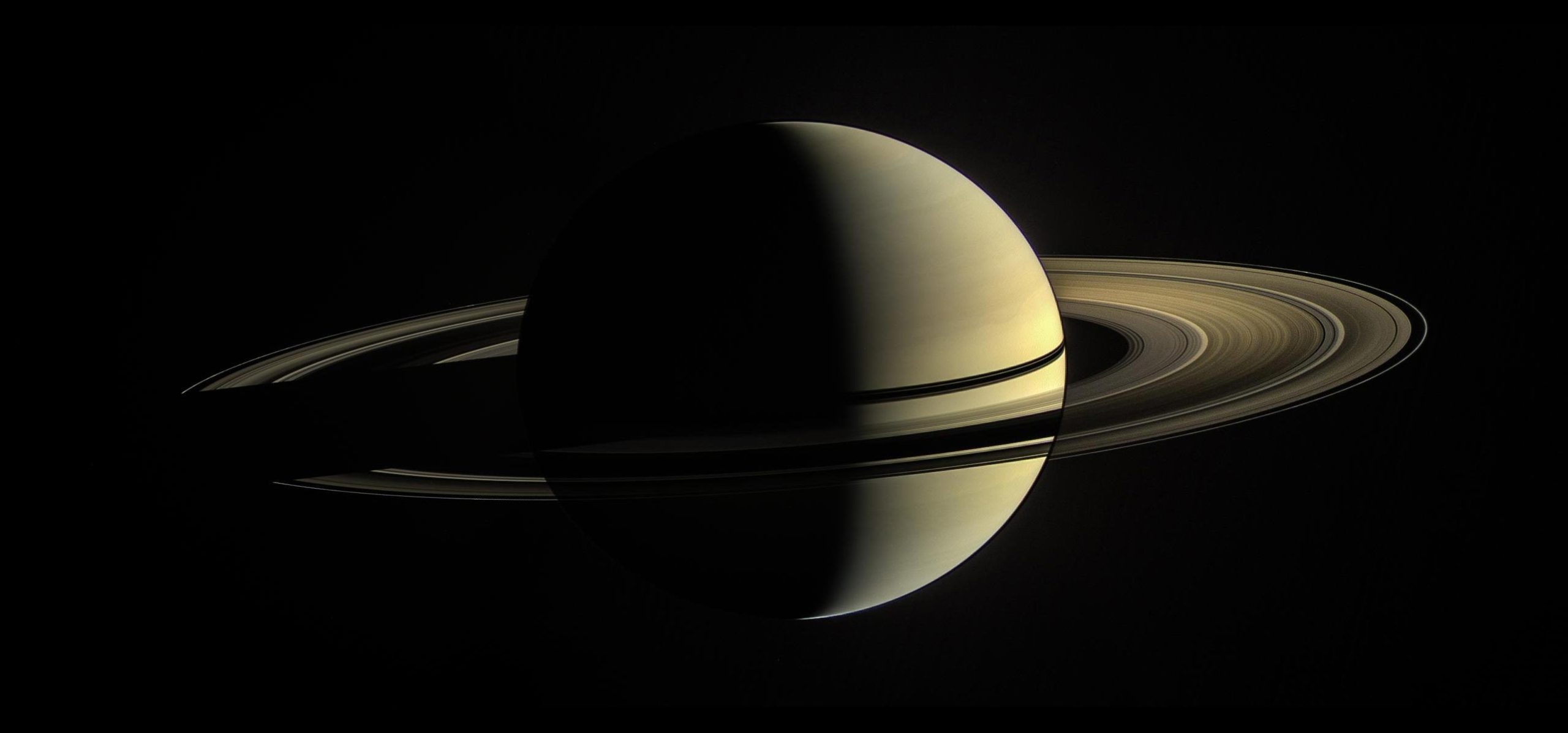
이것은 2010년 1월 2일 토성 주변 궤도에서 본 카시니의 모습입니다. 이 이미지에서 행성의 밤쪽에 있는 고리가 상당히 밝아져 그 특징이 더 분명하게 드러납니다. 낮에는 직사광선과 토성의 구름 꼭대기에서 반사된 빛이 고리를 비춥니다. 이 자연색 풍경은 토성에서 약 140만 마일(230만 킬로미터) 떨어진 거리에서 카시니 우주선의 협각 카메라로 가시광선에서 촬영한 이미지를 합성한 것입니다. 카시니 우주선은 2017년 9월 15일 임무를 종료했습니다. 출처: ASA/JPL-Caltech/Space Science Institute
Cassini mission data suggests that Saturn’s rings are young, possibly only a few hundred million years old, and could disappear in a similar timescale. The rings’ mass, purity, and debris accumulation rates indicate their relatively young age and short lifespan. Two studies show that the rings formed relatively recently and are rapidly losing mass, while a third predicts their disappearance within the next few hundred million years.
While no human could ever have seen Saturn without its rings, in the time of the dinosaurs, the planet may not yet have acquired its iconic accessories – and future Earth dwellers may again know a world without them.
Three recent studies by scientists at NASA’s Ames Research Center in California’s Silicon Valley examine data from NASA’s Cassini mission and provide evidence that Saturn’s rings are both young and ephemeral – in astronomical terms, of course.
The new research looks at the mass of the rings, their “purity,” how quickly incoming debris is added, and how that influences the way the rings change over time. Put those elements together, and one can get a better idea of how long they’ve been around and the time they’ve got left.

Although all four giant planets have ring systems, Saturn’s is by far the most massive and impressive. Scientists are trying to understand why by studying how the rings have formed and how they have evolved over time. Three recent studies by NASA researchers and their partners provide evidence that the rings are a relatively recent addition to Saturn and that they may last only another few hundred million years. Credit: NASA/JPL-Caltech/Space Science Institute
The rings are almost entirely pure ice. Less than a few percent of their mass is non-icy “pollution” coming from micrometeoroids, such as asteroid fragments smaller than a grain of sand. These constantly collide with the ring particles and contribute debris to the material circling the planet. The rings’ age has been hard to pin down, because scientists hadn’t yet quantified this bombardment in order to calculate how long it must have been going on.
Now, one of the three new studies[1] 그것은 비빙하 물질의 총 도착 속도에 대한 더 나은 아이디어를 제공하므로 고리가 형성된 이후 얼마나 멀리 “오염”되었어야 하는지를 알 수 있습니다. 볼더(Boulder)에 있는 콜로라도 대학(University of Colorado)이 주도한 이 연구는 또한 마이크로 운석이 과학자들이 생각하는 것만큼 빨리 오지 않는다는 것을 보여줍니다. 이 증거는 토성과 태양계의 46억년의 작은 부분인 수억년 이상 동안 이 우주 우박 폭풍에 고리가 노출될 수 없다고 말합니다.
이 결론을 뒷받침하는 두 번째 논문은,[2] 작은 우주 암석에 의한 고리의 끊임없는 박동에 대해 다른 각도를 취하는 인디애나 대학교가 주도합니다. 연구 저자들은 연구에서 크게 간과된 두 가지 사항을 확인했습니다. 특히, 그들은 고리의 장기적인 진화를 지배하는 물리학을 살펴보고 두 가지 중요한 구성 요소가 미세 운석의 폭격과 이러한 충돌로 인한 잔해가 고리 내에 분포되는 방식임을 발견했습니다. 이러한 요소를 고려하면 고리가 수억 년 안에 현재의 질량에 도달할 수 있음을 알 수 있습니다. 결과는 또한 그들이 너무 어리기 때문에 토성 시스템 내의 불안정한 중력이 얼음 위성 중 일부를 파괴했을 때 형성되었을 가능성이 있음을 나타냅니다.
Ames의 연구원이자 최근 논문 중 하나의 공동 저자 인 Jeff Causey는 “토성의 상징적 인 주요 고리가 우리 태양계의 최근 특징 일 수 있다는 생각은 논란의 여지가 있습니다. “그러나 우리의 새로운 발견은 다음 세 가지를 보완합니다. 이 발견을 피하기 어렵게 만드는 카시니 측정.” Causey는 토성의 고리에 대한 Cassini 미션에서 학제간 과학자로도 활동했습니다.
그렇다면 토성이 현재의 형태를 취하기까지는 40억 년 이상이 걸렸을 것입니다. 하지만 오늘날 우리가 알고 있는 아름다운 반지를 얼마나 오래 착용할 수 있습니까?
카시니 임무는 물질이 행성의 더 깊은 지역에서 떨어지기 때문에 고리가 빠르게 질량을 잃고 있음을 발견했습니다. 세 번째 종이[3] 또한 인디애나 대학교가 이끄는 연구팀은 고리 모양의 물질이 이 방향으로 얼마나 빨리 표류하는지 처음으로 결정했으며 운석이 다시 역할을 하고 있습니다. 기존 고리 입자와의 충돌과 그 결과 파편이 외부로 던져지는 방식이 결합되어 고리 물질을 토성으로 운반하는 일종의 컨베이어 벨트를 형성합니다. 그 모든 스트리밍 입자가 결국 행성으로 사라지는 것이 무엇을 의미하는지 계산함으로써 연구자들은 토성에 대한 몇 가지 어려운 소식을 내놓았습니다. 토성은 향후 수억 년 안에 고리를 잃을 수 있습니다.
Ames의 연구원이자 세 연구 모두의 공동 저자인 Paul Estrada는 “이 결과는 이 모든 외계 잔해의 끊임없는 폭격이 행성 고리를 오염시킬 뿐만 아니라 시간이 지남에 따라 고리를 약화시켜야 한다는 것을 말해준다고 생각합니다.”라고 말했습니다. “아마도[{” attribute=””>Uranus’ and Neptune’s diminutive and dark rings are the result of that process. Saturn’s rings being comparatively hefty and icy, then, is an indication of their youth.”
Young rings but – alas! – relatively short-lived, as well. Instead of mourning their ultimate demise, though, humans can feel grateful to be a species born at a time when Saturn was dressed to the nines, a planetary fashion icon for us to behold and study.
References:
“Micrometeoroid infall onto Saturn’s rings constrains their age to no more than a few hundred million years” by Sascha Kempf, Nicolas Altobelli, Jürgen Schmidt, Jeffrey N. Cuzzi, Paul R. Estrada and Ralf Srama, 12 May 2023, Science Advances.
DOI: 10.1126/sciadv.adf8537
“Constraints on the initial mass, age and lifetime of Saturn’s rings from viscous evolutions that include pollution and transport due to micrometeoroid bombardment” by Paul R. Estrada and Richard H. Durisen, 9 May 2023, Icarus.
DOI: 10.1016/j.icarus.2022.115296
“Large mass inflow rates in Saturn’s rings due to ballistic transport and mass loading” by Richard H. Durisen and Paul R. Estrada, 9 May 2023, Icarus.
DOI: 10.1016/j.icarus.2022.115221

“요은 베이컨과 알코올에 대한 전문 지식을 가진 닌자입니다. 그의 탐험적인 성격은 다양한 경험을 통해 대중 문화에 대한 깊은 애정과 지식을 얻게 해주었습니다. 그는 자랑스러운 탐험가로서, 새로운 문화와 경험을 적극적으로 탐구하며, 대중 문화에 대한 그의 열정은 그의 작품 속에서도 느낄 수 있습니다.”









